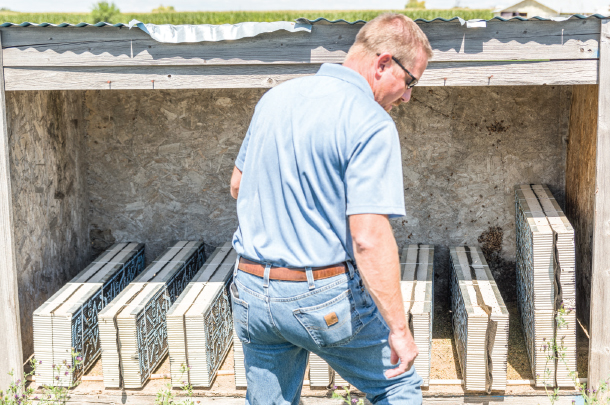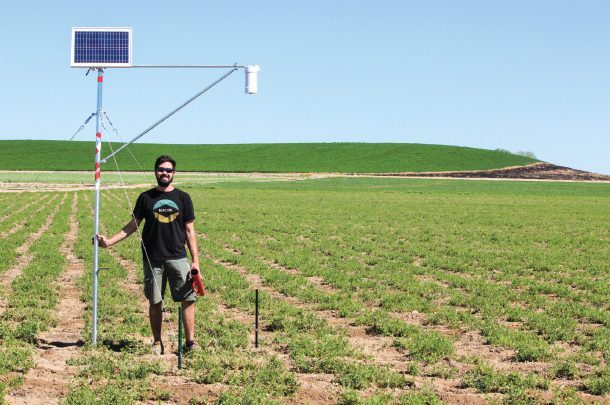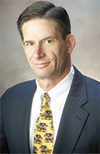Alfalfa plants have an indeterminate growth and flowering habit, flowering over a period of weeks as vegetative growth continues. New flower buds emerge and bloom sequentially near the top of the plant as stem elongation continues over about a three-week period. Good seed yields require adequate pollinator insect activity across most or all of the bloom period.
Alfalfa plants are virtually self-infertile, and seed production requires pollinator insects to cross-pollinate plants. Leafcutter bees are the most widely used pollinator bee in the Northwest, where most of the seed is grown for winter-hardy alfalfa varieties. Seed growers must time the release of their bees into their seed fields, and that timing isn’t as easy to plan as you might think.

Leafcutter bees overwinter as pupae in individual cells composed of leaf material. Cool temperatures keep pupae dormant over winter, but a warm-up period is required for adult bee emergence from their cells, and decisions about when to have bees available must be planned weeks in advance of the onset of bloom.
Alfalfa seed growers must make an educated guess about the developmental progression of their crop toward bloom, then initiate the final warm-up period that brings leafcutter bee pupae out of incubation to emerge as adults ready to pollinate alfalfa fields. If the timing isn’t right, emerging bees can find themselves in alfalfa without bloom.
Bees may leave the field, and bee attrition may leave the seed grower with fewer bees when bloom gets going in earnest later than planned. Or the opposite can happen, with alfalfa in bloom but few active leafcutter bees if bee emergence is timed too late. Either extreme can mean poor pollination and reduced seed yield, so timing is important.
Most alfalfa seed growers develop a good sense of timing. However, a more scientific approach is on the horizon, an approach that could take some of the guesswork out of bee incubation and bloom timing. With a grant from the state of Idaho, researchers at Boise State University teamed up with S&W Seed Company and Kairosys to study the use of remote sensing to monitor alfalfa seed field bloom onset and bloom progression.
“We can see the bloom progress through the spectral signature,” says Nancy Glenn, Boise State professor in the department of geosciences and principal investigator for a project titled “Remote Sensing of Alfalfa Seed Crop Bloom.” She’s been working with graduate student Thomas Van Der Weide and others to monitor bloom progression in alfalfa fields, from vegetative growth to bud stage, through flower initiation and the completion of flowering.
The research team set out with a goal to develop a predictive model to predict the timing of alfalfa bloom in individual fields, so farmers can match bee timing to bloom with greater surety. Doing so requires a reliable method for measuring plant development well in advance of bloom to predict bloom onset and peak bloom. They decided to monitor alfalfa plant development and bloom with three remote sensing methods having differing levels of resolution. These were:
- In-field pole-mounted monitoring for frequent or continuous high-resolution spectral measurement
- UAV or drone-mounted cameras with periodic high-resolution spectral measurement
- Satellite (Sentinel data) for less frequent observations, every five days on a coarser scale
Thomas states, “Our scope included building a real-time, bloom prediction model using near-surface and satellite field imagery.” Thomas collected detailed information at two fields from his ground-based sensors and drone. The team also collected satellite data to track these and other fields, along with pollinator release dates to create their predictive model.
“We collected a lot of data,” says Glenn. “That included field data provided by S&W, remote sensing data from our three sources … and we are developing a predictive model for bloom progression. Remote sensing data can distinguish [among] flowers and buds and leaves. Our hypothesis that alfalfa bloom period can be accurately detected is true. We can walk ourselves along that predictive model to determine the onset of bloom.”
That can be informative and useful when alfalfa seed growers have to make their decisions about leafcutter bee timing and field placement. “We now understand that we can remotely sense and predict that most optimal timing, with measurements made from the ground level or from a satellite,” she says.
The current research project has funding for one more growing season through October 2019. Glenn explains that the grant from the Idaho Global Entrepreneurial Mission (IGEM) is intended to support projects and research that brings university researchers and businesses together.
“The goal is to develop a capability or methodology with partnership between Boise State University and an industry that fuels Idaho’s economy, and this capability is commercialized.”
Glenn concludes, “The idea here is to develop a capability that is useful for agriculture. We are interested in engaging with industry about other crops in addition to alfalfa. We can build on our current lessons learned and bloom model to benefit other pollinator and seed crop species, and ultimately benefit the farmers who grow them.” ![]()
PHOTO 1: Thomas Van Der Weide developed these ground-based pole-mounted stationary sensors to collect information about alfalfa plant growth including bloom over the course of the season. Drone and satellite data were also collected from these same fields. Photo by Silvia Perritte.
PHOTO 2: Bee providers and alfalfa seed growers maintain these leafcutter “bee boards” in temperature controlled storage before setting them out in shaded bee domiciles within alfalfa seed fields. Live pupae are encapsulated within individual cells made from leaf material. Final pupation is temperature-dependent; adult bees emerge as temperatures warm over time. Photo by Scott Newell.
The Alfalfa Bloom Project is a collaborative effort – with participants from industry and the university: Nancy Glenn, Boise State University geosciences and civil engineering faculty and principal investigator; Jai Jaiprakash and Ron Bitner-Kairosys, industry partners that initiated the project; Thomas Van Der Weide, Master of Science geophysics graduate student doing much of the work; Dylan Mikesell, Boise State University geophysics faculty, sensor development and data analysis; S&W Seed Company industry partners Brad Chambers, Stuart Smith and Kirk Rolfs.

-
Robin Newell
- S&W Seed Company
- Email Robin Newell












